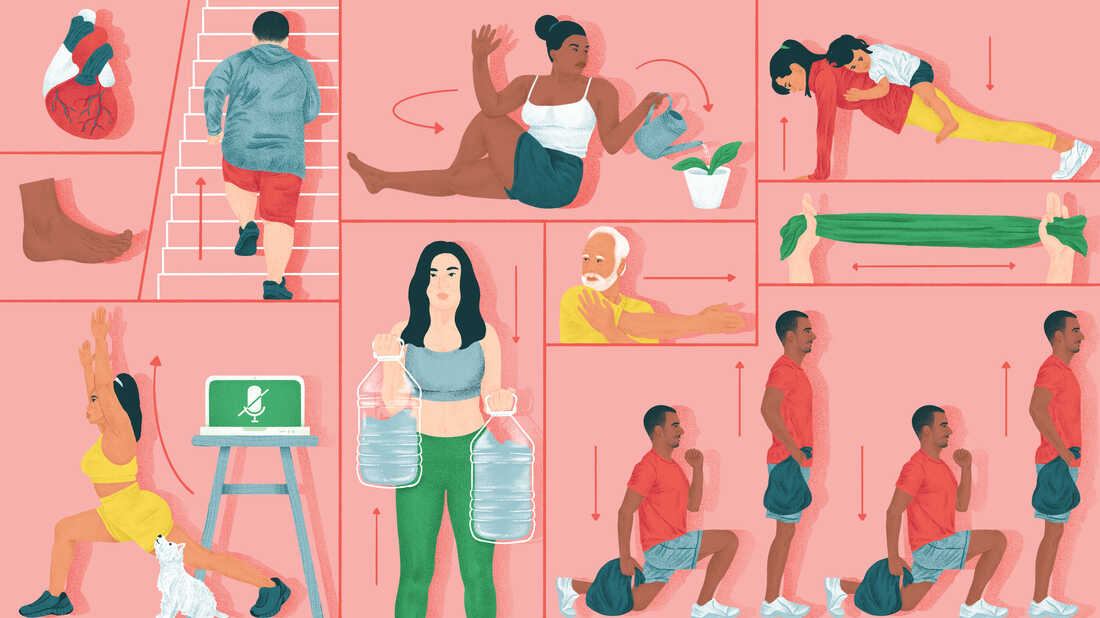
Although it may seem unbelievable, more than half of women avoid exercising in the summer heat. But, you can get plenty of exercise even in the heat. Exercising outdoors offers many benefits. It will keep you cool, refreshed, and fit throughout the month. You will get the most enjoyment from exercise in the warmer months if you choose activities that are enjoyable.
It's not difficult to exercise in summer, but there are some things you should keep in mind. The first is the weather. High temperatures and high humidity in the summer will mean that it will be hot. You may want to stay indoors if you're working out outside during the summer. If the weather is hot, however, it might be impossible to exercise outside. Even worse, you may become dehydrated and possibly even heatstroke.

Finding a shaded area to exercise is the second tip. When exercising outdoors, make sure to choose an area with trees, and if possible, look for city blocks with large trees that cast shade. You'll be able to avoid the heat while still enjoying your workout in cool weather. As you don't have the heat to contend with, you will be more comfortable. And of course, you'll be able to get in more exercise and burn more calories.
While summer is great for exercising, it can prove difficult to maintain the same level of fitness as in cooler seasons. Do your workouts in the morning instead of in the afternoon. If you're not a fan of the heat, you can choose to work out inside or take shady trails. You might consider HIIT (high-intensity interval training) instead. These types allow you to finish the workout in a shorter period of time.
It's also important to exercise in the heat. Summer is the best time to exercise. Don't do it too often. If you're well prepared, it's easier to avoid illness. These simple tips will help you get the most from your summer workouts. You need to be ready for the heat in summer.

If you're exercising outside, you should avoid the hottest part of the day. During the hottest part of the day, it's important to avoid the heat. Otherwise, you might get heat stroke or exhaustion. It is best to schedule your workouts in either the morning or the evening to avoid this. The more time available, the better. The more exercise that you can do and how much time you have to get in, the better. You will be more likely to stick with your routine.
FAQ
How can my blood pressure be controlled?
The first thing you need to do is find out what causes high blood pressure. Next, take steps that will reduce the risk. This could include eating less salt, losing weight if necessary, taking medication, etc.
Exercise is also important. You can also walk if you don’t have the time.
You should join a gym if you are unhappy with your exercise routine. A gym that has other members who are motivated by your goals will be a good choice. It is easier to adhere to a fitness routine when someone else will be there with you.
Exercise: Good or Bad for Immunity?
Exercise is good exercise for your immune system. Your body makes white blood cells that fight infections when you exercise. You also get rid of toxins from your body. Exercise can help prevent heart disease and cancer. It also reduces stress levels.
However, overtraining can damage your immune system. When you exercise too hard, your muscles will become sore. This can cause inflammation and swelling. The body then needs to make more antibodies to fight infection. These extra antibodies can lead to allergies or autoimmune disorders.
So, don't overdo it!
How often should I exercise
Fitness is key to a healthy lifestyle. But, you don't need to spend a specific amount of time exercising. Finding something you enjoy is key. Stick with it.
When you exercise three times per week, aim for 20-30 minutes moderate intensity. Moderate intensity will mean that you'll continue to be exerting yourself afterward. This type works out burns around 300 calories.
For those who prefer to walk, you can go for 10-minute walks four times a week. Walking is low impact and easy on your joints.
Jogging is an alternative to running. You can do it for as little as 15 minutes each day. Running is a great way of burning calories and building muscle tone.
You can start slow if you're new to exercise. You can start with only 5 minutes per week of cardio. Gradually increase the time you do cardio until your goal is reached.
How do I count calories?
You might be asking "What is the best diet?" or "is counting calories necessary?" The answer to this question depends on many factors, including your current health, your personal goals and preferences, as well as your overall lifestyle.
The Best Diet For Me - Which One Is Right For You?
The best diet depends on me, my health, my goals, my preferences and my overall lifestyle. There are many options, both good and bad. Some are better for certain people than others. So what do I do? What can I do to make the right decision?
These are the questions this article will answer. This article begins with a brief overview of the various types of diets that are available today. The pros and cons of each diet are then discussed. Finally, we'll discuss which one is best.
Let's first take a look at different diets.
Diet Types
There are three main types. Low fat, high proteins, and ketogenic. Let's briefly discuss them below.
Low Fat Diets
A low-fat diet restricts fat intake. This is done by reducing your intake of saturated oils (butter, cream cheeses, etc.). and replacing them with unsaturated fats (olive oil, avocados, etc.). A low fat diet is often recommended for those who want to lose weight quickly and easily. This kind of diet could cause problems like constipation or heartburn and indigestion. A person may also experience vitamin deficiencies if they don't get enough vitamins.
High Protein Diets
High protein diets are known to restrict carbohydrate intake and promote the consumption of proteins. These diets have higher protein levels than other diets. These diets are designed to build muscle mass and help you burn more calories. The downside is that they may not provide adequate nutrition for someone who needs to eat regularly. They can also be very restrictive so they may not be suitable for everyone.
Ketogenic Diets
Ketogenic diets also go by the name keto diets. They are high in fat, moderately high in protein and low in carbohydrates. They are commonly used by athletes and bodybuilders, as they allow them train harder and more frequently without getting tired. To avoid side effects such as fatigue, nausea, headaches, or other unpleasant side effects, you must strictly adhere to their instructions.
Is it possible to have a weak immune system due to being cold?
Cold makes you weaker because you have less white blood cells to fight infection. But, cold makes you feel better. Your brain releases endorphins that reduce pain.
Statistics
- WHO recommends reducing saturated fats to less than 10% of total energy intake; reducing trans-fats to less than 1% of total energy intake; and replacing both saturated fats and trans-fats to unsaturated fats. (who.int)
- nutrients.[17]X Research sourceWhole grains to try include: 100% whole wheat pasta and bread, brown rice, whole grain oats, farro, millet, quinoa, and barley. (wikihow.com)
- According to the 2020 Dietary Guidelines for Americans, a balanced diet high in fruits and vegetables, lean protein, low-fat dairy and whole grains is needed for optimal energy. (mayoclinichealthsystem.org)
- WHO recommends consuming less than 5% of total energy intake for additional health benefits. (who.int)
External Links
How To
What does the word "vitamin" mean?
Vitamins can be described as organic compounds found in food. Vitamins allow us to absorb nutrients from food. Vitamins cannot be made by the body; they must be taken from food.
There are two types: water-soluble and fat-soluble vitamins. Water-soluble vitamins dissolve easily when they are dissolved in water. Vitamin C,B1(thiamine), B2 (2riboflavin), and B3 (3niacin), as well as vitamin C,B1, B2 (riboflavin), and B3 (niacin), vitamin B6 (pyridoxine), vitamin folic acid (biotin), pantothenic, and choline are examples. Fat-soluble vitamins can be stored in the liver or in fatty tissue. These include vitamin D, E and K, as well as beta carotene.
Vitamins can be classified by their biological activity. There are eight major categories of vitamins.
-
A - Essential for healthy growth and health maintenance.
-
C - essential for nerve function and energy generation.
-
D - Vital for healthy bones and teeth
-
E is required for good vision and reproduction.
-
K – Required for healthy nerves & muscles.
-
P - Vital for strong bones and teeth.
-
Q - aids digestion and absorption of iron.
-
R is required for the production of red blood cells.
The recommended daily intake (RDA), of vitamins varies with age, gender and physical condition. The U.S. Food and Drug Administration, (FDA), sets the RDA value.
For adults over 19, the RDA for vitaminA is 400 micrograms per daily. Pregnant mothers need 600 micrograms per days because it is vital for the development and growth of their baby. Children ages 1-8 require 900 micrograms per day. Infants under one year of age require 700 micrograms per day, but this amount decreases to 500 micrograms per day between 9 months and 12 months of age.
Children between the ages of 1-18 need 800 micrograms per daily for obesity, while children overweight require 1000 micrograms. Children underweight or obese will need 1200 mg per day.
Children 4-8 years old who have anemia must consume 2200 micrograms of Vitamin C daily.
2000 micrograms per person is necessary for general health. Because of their higher nutrient needs, women who are pregnant or nursing need 3000 mg per day.
Adults over 70 years of age need 1500 micrograms per day since they lose about 10% of their muscle mass each decade.
Women who have been pregnant or are lactating require more than the RDA. Pregnant women require 4000 micrograms daily during pregnancy, and 2500 micrograms every day after birth. Breastfeeding mothers need 5000 mg per day when breastmilk is being produced.